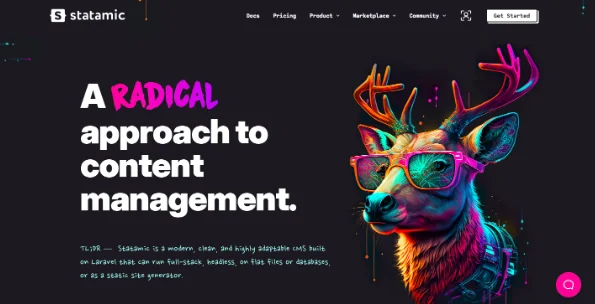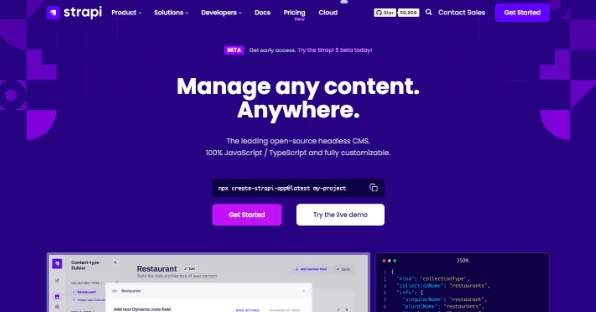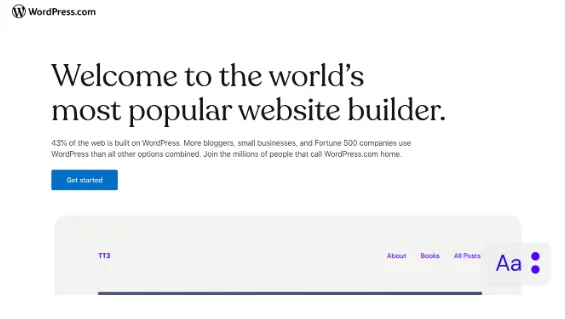Navigating the Web Development Landscape: Analysis of Statamic, Strapi, and WordPress
In the ever-expanding realm of web development, choosing the right content management system (CMS) is paramount to the success of your project. With an array of options available, each boasting unique features and capabilities, developers often find themselves at a crossroads. It's essential to understand the strengths, and challenges associated with each option.
In this blog post, we delve into the comparison of three popular CMS platforms: Statamic, Strapi, and WordPress. By examining their strengths, weaknesses, and suitability for different projects, we aim to provide developers with valuable insights to aid in their web development decision-making process.
Statamic: Simplicity in Motion
In contrast to traditional database-driven CMSs like WordPress, Statamic offers a flat-file approach, utilizing Markdown and YAML files for content management. This lightweight architecture results in faster load times and greater security, as there's no need for a database. Based on the Laravel framework and tailored for building static or dynamic websites, blogs, and content-driven platforms, Statamic focuses on simplicity and ease of use when it comes to web development. Statamic's intuitive control panel makes it an excellent choice for developers seeking a streamlined workflow. However, its limited plugin ecosystem compared to WordPress may pose challenges for those requiring extensive customization or specific functionalities.
Ease of use: Statamic is user-friendly with a straightforward interface for content management. It provides a balance between ease of use and customization.
Flexibility: While offering flexibility in content modeling and templating, Statamic may be less customizable than Laravel for complex applications.
Community and ecosystem: Statamic has a smaller community compared to WordPress or Laravel, but it is active and growing. Its ecosystem is expanding with each release.
Performance: Statamic boasts excellent performance, particularly for content-centric websites, making it a compelling choice for those prioritizing speed.
Learning curve: With a low to moderate learning curve, Statamic is accessible, especially for developers familiar with static site generators.
Target audience: Based on Laravel, Statamic makes it easy to extend the software and integrate your functionalities. For mid-sized to larger projects, this is an ideal candidate. If your project requires a lot of customization you might still be better off developing your own CMS.

Strapi: The Headless Pioneer
Positioning itself as a headless CMS, Strapi separates the backend content management from the frontend presentation layer, providing developers with greater flexibility and control over the user experience. Built on Node.js, Strapi offers a modern stack with a RESTful or GraphQL API out of the box. Strapi is ideal for building headless CMS, APIs, and content-centric applications. It emphasizes flexibility and adaptability in web development. However, its relatively steep learning curve and lack of community support compared to WordPress may deter beginners or those seeking extensive documentation.
Ease of use: Strapi is user-friendly, providing an admin panel for managing content. Its focus on being a headless CMS sets it apart.
Flexibility: Strapi is highly flexible, particularly in handling content structures. As a headless CMS, it empowers developers to create tailored solutions.
Community and ecosystem: Strapi has a growing community with an extensible plugin system. While not as mature as some other frameworks, it is gaining traction rapidly.
Performance: Strapi offers good performance, especially for serving content via APIs. Its architecture aligns well with the demands of modern, decoupled applications.
Learning curve: With a moderate learning curve, Strapi introduces developers to the concept of headless CMS and API development.
Target audience: As a headless solution Strapi can be used for big projects with many moving parts. You can integrate the content delivered by the CMS into your own application or website and watch everything come together.

WordPress: The Content Powerhouse
As one of the most widely-used CMS platforms globally, WordPress is the most known in the realm of content-centric websites, blogs, and small to medium-sized business sites. It has garnered a reputation for its user-friendly interface, extensive plugin ecosystem, and robust community support. Its versatility allows users to create a diverse range of websites, from simple blogs to complex e-commerce portals. However, its reliance on PHP and MySQL can sometimes lead to performance issues, especially with large-scale projects. Additionally, while the abundance of plugins offers flexibility in web development, it can also introduce security vulnerabilities if not managed properly.
Ease of use: WordPress takes the lead in user-friendliness. Its extensive library of plugins and themes allows even non-developers to create and manage websites effortlessly.
Flexibility: While highly customizable through themes and plugins, WordPress may have limitations for complex customizations, especially when compared to more developer-centric frameworks.
Community and ecosystem: Boasting an enormous community and plugin ecosystem, WordPress users benefit from a vast pool of resources, support, and extensions.
Performance: Well-suited for smaller to medium-sized sites, WordPress can be resource-intensive for larger applications. Performance optimization is crucial for scaling.
Learning curve: WordPress has a low learning curve, making it accessible to beginners and those without a programming background.
Target audience: Smaller projects without much need for customization. If you simply want to have a website up and running WordPress will make it easy for you to do so.

Finding Your Framework Fit
The choice between Statamic, Strapi, and WordPress ultimately depends on the specific requirements and objectives of a project. Statamic appeals to developers valuing simplicity, speed, and security, although there are fewer customization options. Strapi caters to those seeking a modern, decoupled architecture with robust API capabilities, suitable for building scalable applications. Meanwhile, WordPress remains a solid option for its ease of use and extensive plugin ecosystem, particularly for smaller-scale websites and blogs.
Consider factors such as scalability, customization needs, developer expertise, and community support when making your decision. Each framework brings its unique strengths to the table, and the key is to align those strengths with your project goals. Whether you prioritize user-friendliness, robust customization, or cutting-edge flexibility, the ideal framework awaits in this diverse landscape of web development.
At solutions.io we work with all of these frameworks, and we have delivered great projects to numerous clients, so, if you are uncertain or unfamiliar with any of these languages, we would be more than happy to have a meeting with you, go through all of these, and chose the right one for your project.

